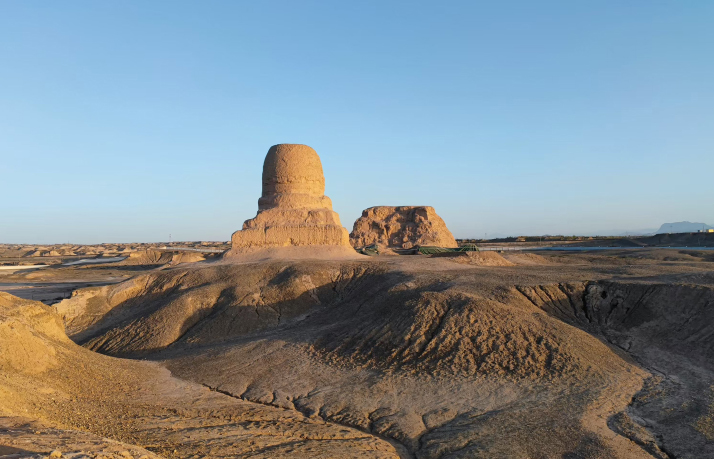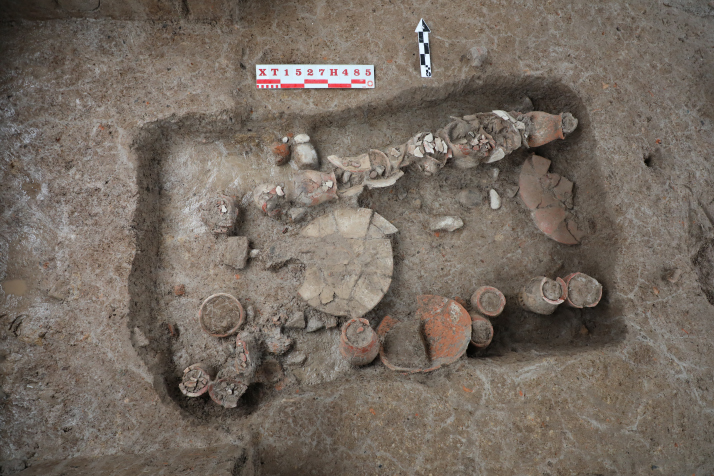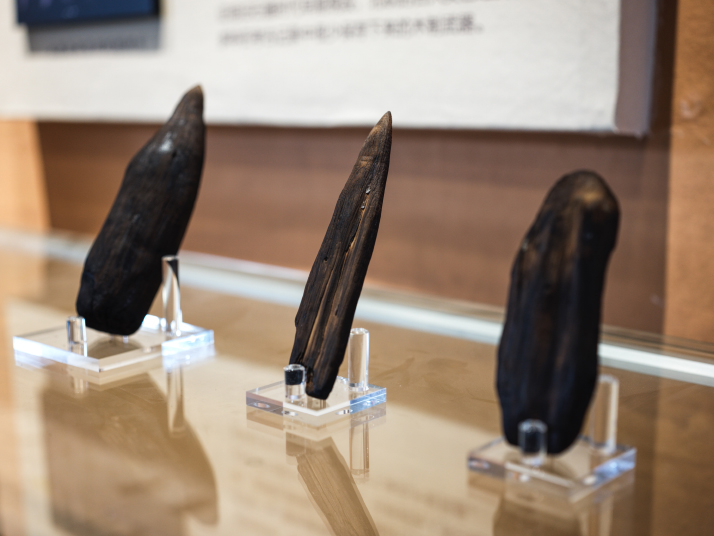| China |
| Key findings shed light on human origins, early Chinese civilization and the influence of the Silk Road | |
|
|
 An undated photo of the Mo'er Temple Site outside Mo'er Village in Kashgar of Xinjiang Uygur Autonomous Region (XINHUA)
China announced on April 24 its top 10 archaeological discoveries of 2024, findings poised to enrich understanding of Chinese civilization and the history of Homo sapiens in East Asia. Homo sapiens is the species to which all modern human beings belong and the only member of the genus Homo that still exists today. The projects on the list encompass a wide range of studies, including human origins, the origins and early development of Chinese civilization and the development of China as a unified multi-ethnic nation, according to Qiao Yunfei, deputy head of the National Cultural Heritage Administration, in an interview with Xinhua News Agency. The annual selection was initiated in 1990 by the China Cultural Relics Newspaper Press and the Archaeological Society of China. The selection process ensures that the discoveries possess historical, artistic and scientific significance, and contribute new information and insights to the field of archaeology. Origins of humans Where did modern humans originate in East Asia? The Mengxihe Site on the top 10 list, located in Ziyang of Sichuan Province, offers systematic and groundbreaking new evidence to help answer this question. From 2022 to 2024, thousands of stone tools, animal fossils, large and medium-sized wooden artifacts, and remains of plant seeds and fruits were excavated from the site, which was first discovered in 2021. Dating back 60,000 to 80,000 years, the Mengxihe Site represents a crucial period in the evolution of modern humans. At the final meeting held to select the top 10, which took place in Beijing on April 23-24, Zheng Zhexuan, Director of the Paleolithic Archaeology Institute of the Sichuan Provincial Cultural Relics and Archaeology Research Institute, said the area is speculated to have been a verdant lakeside habitat rich in water and vegetation. The unique water-saturated environment allowed for the exceptional preservation of stone, bone and wooden tools, as well as organic materials such as animal and plant remains, including the 180,000 animal fossils and more than 60,000 plant seeds already unearthed. Zheng added that organic matter, especially plant remains, is extremely difficult to preserve, even sites only a few hundred years old rarely yield any such evidence. The sheer abundance of precious plant remains unearthed at Mengxihe makes it the world's only site to have yielded such rich botanical finds from the Middle Paleolithic Period, providing unprecedented physical material for studying the lifestyles of Paleolithic humans. The Paleolithic Period (approximately 3 million to 10,000 years ago), also known as the Old Stone Age, is a cultural stage of human development characterized by the use of rudimentary chipped stone tools. Among the plant remains discovered at the site, an unexpected find has garnered attention: Sichuan peppercorns. A staple seasoning in Chinese cuisine today, the discovery suggests that Sichuan peppercorn may also have been used as far back as the period. The site also revealed compelling evidence of grilling: numerous charred plant seeds and bones, several roasted skull bones of Stegodon (an extinct elephant-like mammal), and hearths. These findings confirm that grilling was likely an important method of food processing for the Paleolithic humans living there. Furthermore, the medicinal plants unearthed, such as Chinese elder, suggest that the exploration of the medicinal properties of plants may have begun tens of thousands of years earlier than previously recorded in written sources. Perhaps most surprisingly, the site yielded numerous artifacts bearing artificial scratch marks, found not only on bones but also on stones and plants. This is the first centralized discovery of evidence of symbolic behavior during the early Paleolithic period in East Asia, providing valuable material for the study of the abstract thinking abilities of Paleolithic humans. The discoveries made at the site also shed light on the status of people living there. "Judging from the scale of the site, which covers more than 100 square km and includes more than 80 site locations, human activity in the Sichuan Basin was actually quite prosperous during that era," Zheng said at the meeting.  A high-status tomb at the Xiatang Site in Xiatang Village, Taizhou City, Zhejiang Province on March 22 (XINHUA)
Early Chinese civilization The Xiatang Site on the top 10 list provides valuable insights into the layout and development of settlements during the middle and late phases of the Shangshan Culture. The site, located in Xiatang Village, Taizhou City, Zhejiang Province, was first discovered in 1984. But it was not until 2018 that the Zhejiang Provincial Institute of Cultural Relics and Archaeology began a formal archaeological excavation of the site. Excavation has continued to today, and so far, the cumulative excavation area spans 2,250 square meters. The site's central and western sections feature central terraces encircled by over 10 artificially constructed earthen platforms dating back to the Shangshan Culture period, between 8,300 and 10,000 years ago. A ring moat forms the outermost boundary, creating a distinct triple-layered settlement structure. The Shangshan Culture was first discovered by Chinese archaeologists while excavating a Neolithic site in Shangshan Village, Pujiang County, Zhejiang, in November 2000. Since then, more relic sites in the province, dating to the culture's early, middle and late stages, have been found. The Neolithic period, lasting from around 10,000 years ago to 5,000 to 4,000 years ago, was characterized by stone tools shaped through polishing or grinding, dependence on domesticated plants and animals, settlement in permanent villages, and the emergence of crafts such as pottery and weaving. Importantly, archaeologists unearthed three high-status tombs dating to the late Shangshan Culture period on the earthen platforms in the eastern part of the site. These rectangular tombs each contain more than 20 pottery burial objects. This discovery indicates that with the support of the rice-farming economy, social stratification began to emerge within Shangshan Culture around 9,000 years ago. "The Xiatang Site is the earliest agricultural settlement in China, presenting a panoramic view of the settlement patterns and structures of early agricultural societies. It provides us with a vital specimen for studying early rice-farming societies in south China," Chen Xingcan, a researcher at the Institute of Archaeology of the Chinese Academy of Social Sciences, stated at the final assessment meeting.  Wooded artifacts unearthed from the Mengxihe Site in Ziyang, Sichuan Province, on April 8 (XINHUA)
Cultural exchange Another significant finding, the Mo'er Temple Site, is located on a high platform outside Mo'er Village in Kashgar of Xinjiang Uygur Autonomous Region. The site features a square stupa and a round stupa (Buddhist ceremonial structures). They are the westernmost and best-preserved earthen stupas discovered in China. Archaeological dating suggests that the site was originally constructed in the 1st century and underwent various renovations and expansions across different historical eras before being gradually abandoned after the 10th century. The site was discovered during the late 19th and early 20th centuries. In 2019, Minzu University of China and the Xinjiang Institute of Cultural Relics and Archaeology collaborated on an archaeological excavation of the site. Over nearly six years of excavation, archaeologists have uncovered dense architectural remains, including the foundations of the two stupas and 62 rooms within 18 separate buildings, including monks' residences, Buddhist halls and kitchens. Based on the findings from the 2024 excavation, archaeologists hypothesize that the round stupa originally served as the central point of the temple. As the number of monks at Mo'er Temple grew, the temple was expanded, leading to the construction of the adjacent square stupa and additional supporting facilities nearby. Its location along the ancient Silk Road crossroads ensured that the temple's architecture and unearthed relics integrated diverse cultural elements from India, Central Asia, Xinjiang and the Central Plains. The Central Plains—encompassing modern-day Henan, southern Hebei, southern Shanxi and western Shandong provinces—has historically served as the nucleus of China's political, economic and cultural development. Huo Wei, a professor of archaeology at Sichuan University, told Guangming Daily newspaper that the site's blend of local characteristics and Central Plains influence demonstrates that Buddhism began its process of Sinicization as soon as it entered the vast areas north and south of the Tianshan Mountains in Xinjiang. Copyedited by G.P. Wilson Comments to jijing@cicgamericas.com |
|
||||||||||||||||||||||||||||
|